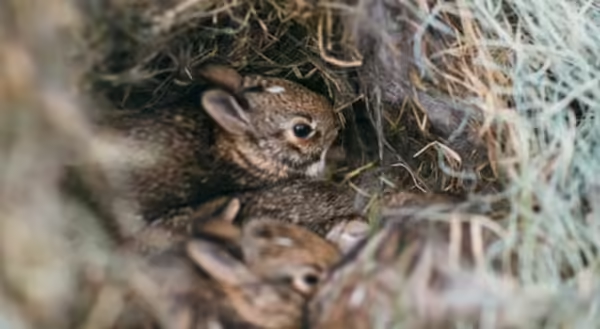
Spring is the season of new beginnings. Wildlife baby season in Illinois starts as early as February when great horned owls lay their eggs and frogs begin to call. Coyote pups are born in March and soon a flurry of animals continue courting, mating, and preparing for what will be the next generation of their species.
Every spring, people must battle nature vs. nuture when coming across new offspring. I am not going to tell you to simply let nature take its course (though that is the appropriate response) because it would make this naturalist a complete hypocrite.
Nature is tough sometimes and we are in a situation where our hearts are raw and we want to help in any way. That said, you do not want to kidnap baby animals from their parents so think through any rescue ideas fully before taking any steps to “help” wildlife. This Human Wildlife Conflict Resolution Guide has helpful information on daily wildlife dilemas.
Is a baby animal abandoned, injured, or fine?
For wildlife rehabilitators, spring is the beginning of the long rescue season with many endless days. The biggest issue with baby animals is deciding if they are abandoned, injured, or just fine though small and uncoordinated.
What to consider when you find a baby wild animal
- Safety: First and foremost is your safety. A bird of prey, even as a juvenile, has some wicked tools to protect itself and it has no idea you are wanting to help. Next, if it is directly in harm’s way is it possible to safely coax it a few yards to a safe place.
- Does it need help? Observe the animal for a while and consider it may just be young and waiting for a parent to arrive with food. Young owls start by leaving the nest and doing what we call “branching.” At this point they flop around in the trees and often drop to the ground. You are correct if you observe the fact they cannot fly back up into the trees, but they will actually use their feet and beaks to pull themselves up building the muscles in their necks and shoulders which they will use to eventually fly.
Species specifics
Rabbits
In urban settings, the most common early babies found are probably bunnies. Eastern cottontail rabbits are prolific and start breeding very early in the year with multiple litters throughout the summer. By the time you read this, we are multiple litters into bunny season.
We must remember they are a huge support species to the overall food chain, so we need lots of them. Rabbits are only in the nest a short time so if you can walk any pets on a leash until they have distributed it will create less heartache. If you find a baby bunny and its eyes are open, even though it fits in the palm of your hand, it is fine and able to be on its own. Mom may still nurse them, but they are fully capable to survive without her at this point.
Birds
Songbirds are protected species and probably the next most “rescued” animals. This guide can help you make the decision about rescuing. The olfactory lobe of the brain, the one that controls sense of smell, is not developed in most birds so they cannot tell you touched the bird. Yes, we were all lied to.
- If you find a baby bird with little to no feathers its best chance is to get it safely back into the nest. Putting it in a covered warm location while finding and preparing to put it back will keep it from getting hypothermia.
- If it is clearly wounded call a wildlife rehabilitator for advice on how best to capture, transport, and get the animal to them.
- If, however, the baby bird is somewhat feathered and sitting on the ground just waiting, it is a fledgling and waiting for a parent. Young birds will spend days to weeks as fledglings so try to avoid “saving” them as they are doing what they need to do. Leave the area and you may be able to stand out of sight and observe the parent feeding it.
Deer
Our largest baby people think they need to save is the white-tailed deer fawns because they are often found alone and assumed abandoned. Their strategy for staying alive is based on this exact condition of aloneness. The mother will be in the area and will nurse the fawn as needed but she will stay away for at least the first three weeks. Fawns have scent glands that are not functioning in those initial weeks after birth so predators cannot locate them as easily. If you see a fawn curled up and resting, get away from it as quickly as possible do not check on it.
Want to get notified when new Naturalist News posts are available? SIGN UP HERE!
MEET THE AUTHOR
Peggy Doty is an energy and environmental stewardship educator who has been with University of Illinois Extension for more than 20 years. She holds a B.S. in zoology from Southern Illinois University and a Master of Educator from Northern Illinois University. She is interested in human and wildlife interactions, supporting native pollinators and water resources.
Naturalist News is a blog by University of Illinois Extension Master Naturalist staff and volunteers who bring you stories highlighting the individuals, places, wildlife and plants that make this state amazing. Join us each week to learn something new, be inspired and become connected to your own community by recognizing the amazing ways we are all intertwined.